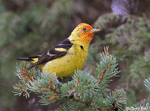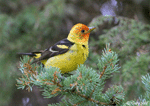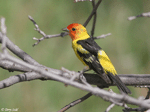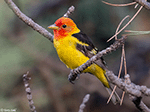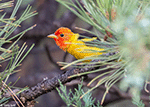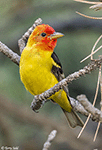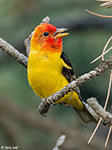Western Tanager
Piranga ludoviciana
| Length: 7 inches | Wingspan: 11.5 inches | Seasonality: Summer/Migrant |
| ID Keys: Yellow body, black wings and tail, reddish head (male). Female olive with darker wings, white wing bars. | ||
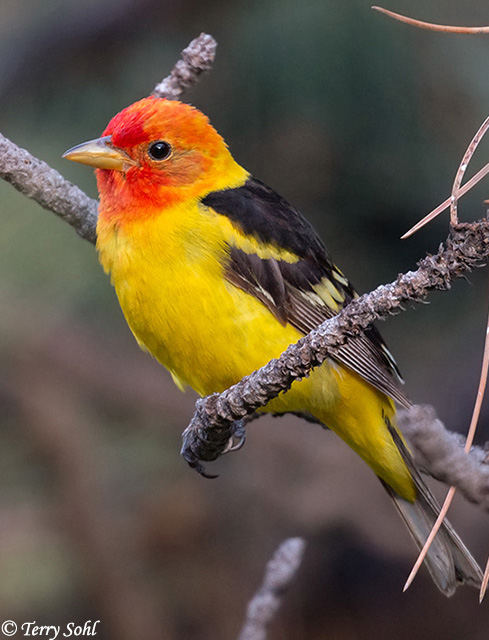 Western
Tanagers are western North America's brilliantly colored equivalent of eastern
North America's Scarlet Tanager, although
with a dramatically different, fiery yellow and orange plumage on breeding
males. Western Tanagers are the most northerly of the Tanagers found in North
America., summering as far north as northern British Columbia. They prefer
higher elevation conifer forests for breeding, and in South Dakota, are most often found in the Black Hills.
Western
Tanagers are western North America's brilliantly colored equivalent of eastern
North America's Scarlet Tanager, although
with a dramatically different, fiery yellow and orange plumage on breeding
males. Western Tanagers are the most northerly of the Tanagers found in North
America., summering as far north as northern British Columbia. They prefer
higher elevation conifer forests for breeding, and in South Dakota, are most often found in the Black Hills.
Habitat:
Prefers conifer or mixed forest and woodland. Seems to prefer open conifer forest more than dense forest.
Diet:
Primarily insects, especially early in the summer when raising young. Later during the breeding season they begin to eat more fruits and berries.
Behavior:
Primarily forages in mid to upper-levels of the forest canopy, deliberately moving through foliage and plucking insects from the foliage. They will also sit at a perch and scan for insects, flying out to capture them when spotted.
Nesting:
June and July. The nest of a Western Tanager is constructed on the branch of a tree, anywhere from 5 to over 50 feet from the ground. The female builds the nest, which is a loose bowl constructed on a base of interwoven twigs and roots, with a smaller cup lined with grasses, weeds stems, rootlets, moss, hair, feathers, or other finer material. The female alone incubates the eggs, although the male may stay in the vicinity and chase off intruders, and occasionally may bring the female food. Incubation lasts about 12-14 days, with the young fledging from the nest after another 12-14 days.
Song:
The song of a Western Tanager is a series of very short, rising and falling musical phrases lasting 2-4 seconds. They have multiple calls, including a short musical pip-er-lick phrase, and some more harsh chattering.
1Click here to hear the song of a male Western Tanager
2Click here to hear mixed calls and song of a Western Tanager
3Click here to hear the calls of a female Western Tanager
4Click here to hear more songs of a male Western Tanager
Migration:
Summers in the western U.S. and Canada. Winters in Mexico, Central America, and South America.
Interactive eBird map:
Click to access an interactive eBird map of Western Tanager sightings
Similar Species:
Male Western Tanagers have such a unique plumage that they are unlikely to be confused with any other species. Female Western Tanagers could potentially confused with the followign:
- Scarlet Tanager - Normally differentiating between female Western and Scarlet Tanagers isn't an issue, as there's normally no overlap in range between the two species. However, in recent years we've seen multiple astray Western Tanagers in eastern South Dakota, in habitats where Scarlet Tanagers are also found. The easiest way to differentiate the two is that female Scarlet Tanagers lack the obvious wingbars found on a female Western Tanager.
- Summer Tanager - Summer Tanagers are rare migrants in South Dakota, and thus not likely to be found aside areas where Western Tanagers are found. However, where the two species do potentially come into contact, female Summer Tanagers can be differentiated from female Western Tanagers by their overall, consistent yellowish coloring, while Western Tanager females have a yellowish body, darker wings, and obvious wingbars.
Bird Feeders:
Will come for cut fruit, nectar, and baked goods.
Conservation Status:
Overall numbers currently appear to be stable, with no major threats to their population, and there are some indications that populations are increasing in parts of their range. They are common in many parts of their range, and are found over a broad geographic area. As a result, the IUCN considers the Western Tanager to be a species of "Least Concern".
Further Information:
Photo Information:
July 13th, 2019 - Roby Canyon, Black Hills of South Dakota - Terry Sohl
Additional Photos:
Click on the image chips or text links below for additional, higher-resolution Western Tanager photos.
Audio File Credits:
1Peter Ward and Ken Hall. Recorded in British Columbia on June 24th, 1991. Original recording and information available from xeno-canto.
2Thomas Magarian. Recorded in Hood River County of Washington state on July 27th, 2018. Original recording and information available from xeno-canto.
3Frank Lambert. Recorded in Mariposa County, California on May 21st, 2015. Original recording and information available from xeno-canto.
4Jeremy Minns. Recorded in Sierra County, California on June 13th, 2000. Original recording and information available from xeno-canto.
| Click on the map below for a higher-resolution view |
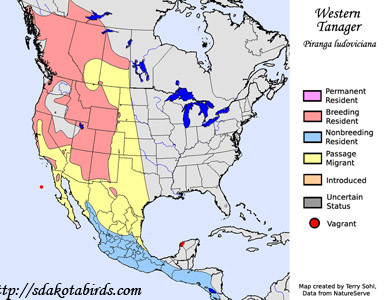 |
| South Dakota Status: Uncommon migrant and local summer resident in the far western part of the state, particularly in the Black Hills. Rare migrant elsewhere in the state. |
Additional Western Tanager Photos
Click for a higher-resolution version of these photos
